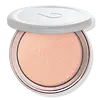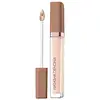What's inside
What's inside
 Key Ingredients
Key Ingredients

 Benefits
Benefits

 Concerns
Concerns

 Ingredients Side-by-side
Ingredients Side-by-side

Dimethicone
EmollientMica
Cosmetic ColorantC30-45 Alkyl Dimethicone
Skin ConditioningSilica
AbrasiveSynthetic Wax
AbrasiveDimethicone/Vinyl Dimethicone Crosspolymer
Skin ConditioningButyl Avocadate
Skin ConditioningDimethiconol
EmollientLauroyl Lysine
Skin ConditioningCocos Nucifera Oil
MaskingPassiflora Edulis Seed Oil
EmollientIsopropyl Myristate
EmollientBisabolol
MaskingParfum
MaskingHydrogenated Coconut Oil
EmollientSaccharide Isomerate
HumectantLinalool
PerfumingTocopherol
AntioxidantCitronellol
PerfumingAloe Barbadensis Leaf Extract
EmollientZingiber Officinale Root Extract
MaskingPanax Ginseng Root Extract
EmollientCI 77891
Cosmetic ColorantCI 77491
Cosmetic ColorantDimethicone, Mica, C30-45 Alkyl Dimethicone, Silica, Synthetic Wax, Dimethicone/Vinyl Dimethicone Crosspolymer, Butyl Avocadate, Dimethiconol, Lauroyl Lysine, Cocos Nucifera Oil, Passiflora Edulis Seed Oil, Isopropyl Myristate, Bisabolol, Parfum, Hydrogenated Coconut Oil, Saccharide Isomerate, Linalool, Tocopherol, Citronellol, Aloe Barbadensis Leaf Extract, Zingiber Officinale Root Extract, Panax Ginseng Root Extract, CI 77891, CI 77491
Water
Skin ConditioningCI 77891
Cosmetic ColorantBis-Stearyl Dimethicone
EmollientCaprylyl Methicone
Skin ConditioningIsohexadecane
EmollientCetyl PEG/PPG-10/1 Dimethicone
EmulsifyingGlycerin
HumectantIsononyl Isononanoate
EmollientDiphenyl Dimethicone
EmollientPolyglyceryl-4 Isostearate
EmulsifyingTrimethylsiloxysilicate
EmollientC30-45 Alkyl Dimethicone
Skin ConditioningStearyl Dimethicone
EmollientCI 77492
Cosmetic ColorantAlumina
AbrasiveButylene Glycol
HumectantBoron Nitride
AbsorbentSodium Potassium Aluminum Silicate
Phenoxyethanol
PreservativeSodium Chloride
MaskingDisteardimonium Hectorite
StabilisingCI 77491
Cosmetic ColorantPotassium Sorbate
PreservativeSodium Dehydroacetate
PreservativeCaprylic/Capric Triglyceride
MaskingTriethoxycaprylylsilane
Tocopheryl Acetate
AntioxidantSilica Dimethyl Silylate
EmollientC20-24 Olefin
Skin ConditioningSilica
AbrasivePropylene Carbonate
SolventCI 77499
Cosmetic ColorantParfum
MaskingVitis Vinifera
MaskingWater, CI 77891, Bis-Stearyl Dimethicone, Caprylyl Methicone, Isohexadecane, Cetyl PEG/PPG-10/1 Dimethicone, Glycerin, Isononyl Isononanoate, Diphenyl Dimethicone, Polyglyceryl-4 Isostearate, Trimethylsiloxysilicate, C30-45 Alkyl Dimethicone, Stearyl Dimethicone, CI 77492, Alumina, Butylene Glycol, Boron Nitride, Sodium Potassium Aluminum Silicate, Phenoxyethanol, Sodium Chloride, Disteardimonium Hectorite, CI 77491, Potassium Sorbate, Sodium Dehydroacetate, Caprylic/Capric Triglyceride, Triethoxycaprylylsilane, Tocopheryl Acetate, Silica Dimethyl Silylate, C20-24 Olefin, Silica, Propylene Carbonate, CI 77499, Parfum, Vitis Vinifera
 Reviews
Reviews

Ingredients Explained
These ingredients are found in both products.
Ingredients higher up in an ingredient list are typically present in a larger amount.
C30-45 Alkyl Dimethicone is a type of silicone.
Ci 77491 is also hydrated iron III oxide. It's sole purpose is to give a red/pink hue to products.
Iron III oxides are classified as inorganic chemicals for coloring.
Synthetically created Ci 77491 is considered safer than those naturally found. This is because the synthetically created version may contain less impurities. Iron oxides are generally non-toxic and non-allergenic.
Learn more about CI 77491Ci 77891 is a white pigment from Titanium dioxide. It is naturally found in minerals such as rutile and ilmenite.
It's main function is to add a white color to cosmetics. It can also be mixed with other colors to create different shades.
Ci 77891 is commonly found in sunscreens due to its ability to block UV rays.
Learn more about CI 77891Parfum is a catch-all term for an ingredient or more that is used to give a scent to products.
Also called "fragrance", this ingredient can be a blend of hundreds of chemicals or plant oils. This means every product with "fragrance" or "parfum" in the ingredients list is a different mixture.
For instance, Habanolide is a proprietary trade name for a specific aroma chemical. When used as a fragrance ingredient in cosmetics, most aroma chemicals fall under the broad labeling category of “FRAGRANCE” or “PARFUM” according to EU and US regulations.
The term 'parfum' or 'fragrance' is not regulated in many countries. In many cases, it is up to the brand to define this term.
For instance, many brands choose to label themselves as "fragrance-free" because they are not using synthetic fragrances. However, their products may still contain ingredients such as essential oils that are considered a fragrance by INCI standards.
One example is Calendula flower extract. Calendula is an essential oil that still imparts a scent or 'fragrance'.
Depending on the blend, the ingredients in the mixture can cause allergies and sensitivities on the skin. Some ingredients that are known EU allergens include linalool and citronellol.
Parfum can also be used to mask or cover an unpleasant scent.
The bottom line is: not all fragrances/parfum/ingredients are created equally. If you are worried about fragrances, we recommend taking a closer look at an ingredient. And of course, we always recommend speaking with a professional.
Learn more about ParfumSilica, also known as silicon dioxide, is a naturally occurring mineral. It is used as a fine, spherical, and porous powder in cosmetics.
Though it has exfoliant properties, the function of silica varies depending on the product.
The unique structure of silica enhances the spreadability and adds smoothness, making it a great texture enhancer.
It is also used as an active carrier, emulsifier, and mattifier due to its ability to absorb excess oil.
In some products, tiny microneedles called spicules are made from silica or hydrolyzed sponge. When you rub them in, they lightly polish away dead skin layers and enhance the penetration of active ingredients.
Learn more about Silica